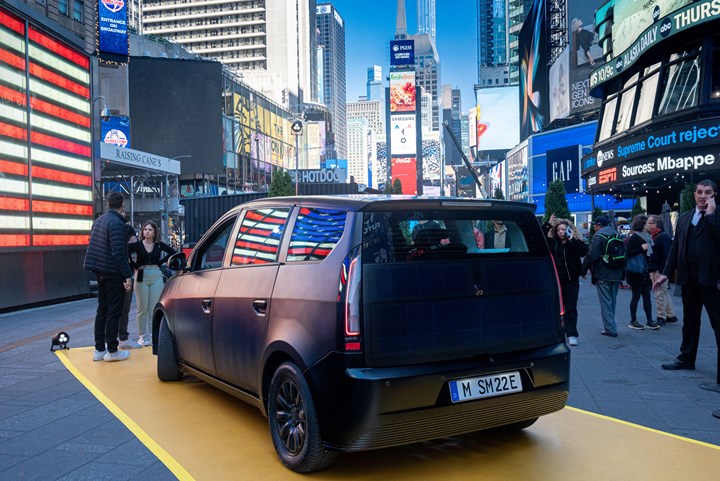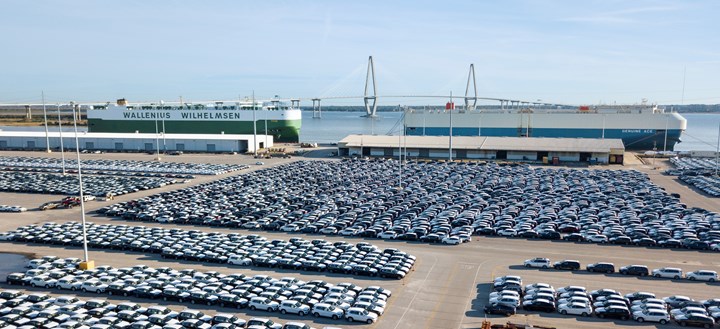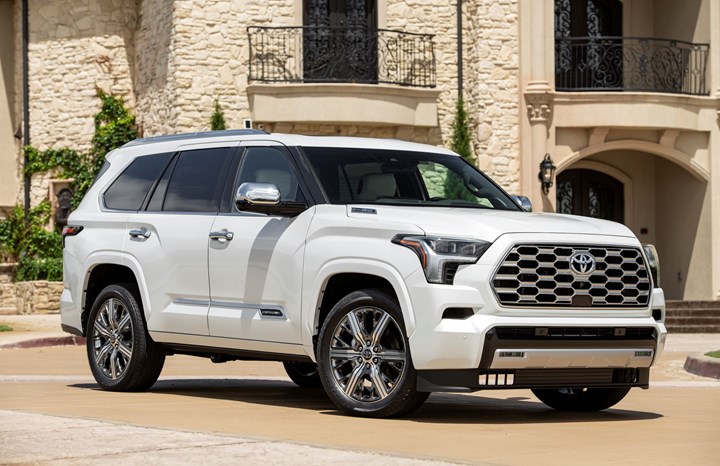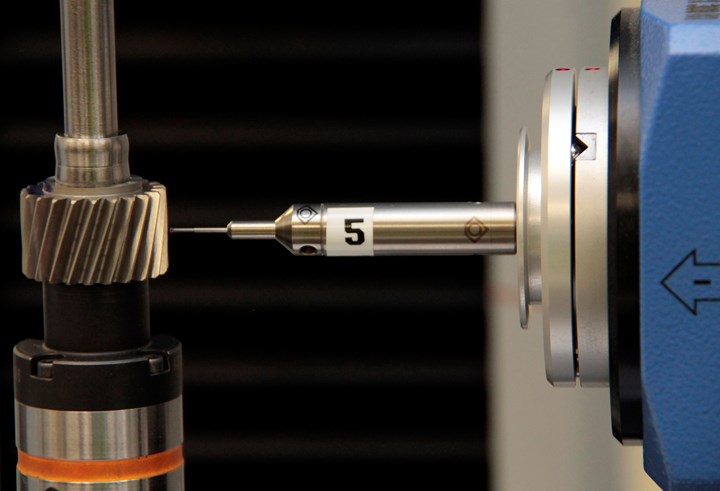on Sion's end, vehicle ratings, brand loyalty, BEV big rigs, Toyota Sequoia, & Stellantis leverages resources
Why Sono Motors ended Sion. . .how OEMs are rated by CR. . .Tesla has lots of loyalists. . .Conti uses interior cameras for identifying drivers. . .using alternative power in the Port of Los Angeles. . .Toyota’s top-of-the-line Sequoia. . .Stellantis leverages manufacturing base
Sun Sets on Sion

Not even a reveal in Times Square could save the Sono Motors Sion solar-powered vehicle. (Image: Sono Motors)
Sono Motors, a German company, developed a five-passenger, battery-powered (54-kWh LFP battery) vehicle that has a range of ~190 miles, which doesn’t seem like a whole lot—unless you know two things about the Sion:
- The expected MSRP for the vehicle was in the $25,000 vicinity
- The body panels of the vehicle includes 456 integrated solar cells
Yes, a solar-powered EV.
Starting late last year Sono Motors started a campaign to get reservations for the Sion and consequently some cash to keep the vehicle program running. It even conducted a tour of the vehicle in the U.S., with stops in New York, Boston, Detroit, San Francisco, and L.A.
Alas, last week the company announced it is terminating the Sion vehicle program.
The >45,000 reservations and preorders weren’t sufficient to make the business case for the vehicle.
So the company is “implementing a significant cost reduction program”—and we all know what that means. Unfortunately, some 300 people will know all too well.
It is not abandoning its efforts to apply solar tech to vehicles, however.
It will focus on supplying third-party OEM cars, buses, refrigerated vehicles, and RVs with solar panels.
Sort of a silver lining
Laurin Hahn, co-founder and CEO of Sono Motors:
“Even though we had to terminate our original passion project, the Sion program, shifting our entire focus to business-to-business solar solutions provides us with an opportunity to continue to create innovative products in the solar space.”
One of those products is the “Solar Bus Kit,” which is to be commercially available in Q2.
The company’s current customers include Mitsubishi Europe, Scania, and MAN Truck & Bus.
Making cars is hard
Although Sono Motors has 52 patents filed or granted—42 in the solar space—and had thought the Sion “was on a trajectory to become a disruptor in the automotive solar technology industry,” one could argue that there simply isn’t an “automotive solar technology industry” and that for a start-up to gain traction—or simply to continue to exist—it is necessary to go beyond tech to having volume, too.
Scale matters in this space.
///
Two Interesting Things About Consumer Reports’ Auto Scoring

BMW did quite well in Consumer Reports’ testing. And all of those BMWs in this picture are part of the 227,029 vehicles built in Spartanburg, South Carolina and exported last year, making BMW Manufacturing the leading company for automotive exports by value, the ninth year in a row. (Image: BMW)
1. Of the Top 10 vehicles selected in the Consumer Reports annual assessment, 70% are in the “electrified” category, with only the Toyota Corolla Cross, Subaru Forester, and Kia Telluride being outliers. (And Jake Fisher, CR’s senior director of automotive testing, noted a Corolla Cross hybrid is on its way. Fisher also referred to the hybrid Maverick pickup that’s on the list as a “gamechanger” that “really, really impressed us,” so evidently electrification is gaining a whole lot of cred.)
The 10 vehicles:
- Toyota Corolla Hybrid
- Toyota Corolla Cross
- Subaru Forester
- Toyota Camry Hybrid
- Ford Maverick Hybrid
- Nissan Leaf
- Hyundai Santa Fe Hybrid
- Kia Telluride
- Lexus NX350h
- Tesla Model 3
2. The CR Brand Report Card takes into account road testing, reliability, owner satisfaction, and safety. Not price.
And while there seem to be ties, according to Fisher, there are no ties in automotive, that there are numbers to the right of the decimal point (not provided), so while companies have the same whole number, the different numeric ranking is the right one.
- BMW 81 points
- Subaru 79
- Mini 79
- Lexus 77
- Honda 77
- Toyota 76
- Genesis 76
- Mazda 75
- Audi 74
- Kia 73
- Acura 72
- Buick 71
- Hyundai 71
- Porsche 70
- Dodge 68
- Lincoln 66
- Tesla 66
- Infiniti 65
- VW 64
- Volvo 64
- Nissan 63
- Ford 63
- Chevy 62
- Cadillac 62
- Chrysler 62
- Mercedes 56
- GMC 55
- Mitsubishi 54
- Alfa Romeo 53
- Jaguar 52
- Jeep 46
- Land Rover 45
An interesting thing about the rankings is that CR shows the number of vehicles it tested for a given brand and the number of those that it recommends.
Only four companies have a 1:1 relationship.
- BMW 9 vehicles
- Mini 2
- Honda 6
- Buick 3
There is something to be said for consistency (but then again, most people buy one vehicle at a time, so that 1:1 may be irrelevant to the choice).
///
Loyalty Matters
Speaking comparative analysis. . .
One of the metrics that OEMs pay assiduous attention to is “conquest”: whether a given product has caused a customer to switch from another brand to buy it.
Another: “lifetime customer value”: it isn’t just about selling the first truck, but the second, third, fourth. . .as well.
Both of these factors are affected by “Loyalty.”
For the past 27 years S&P Global Mobility has been tracking loyalty. Earlier this week it released results for its “Automotive Loyalty Awards.”
General Motors certainly has a loyal customer base.
The corporation received the S&P Global Mobility Award for Overall Loyalty to Manufacturer.
This is the eighth time in a row GM has received it. And it is the 19th win in the 27 years of the assessment.
How do they do it?
The firm analyzed 11.7 million new vehicle registrations for calendar year 2022.
“Loyalty” is whether the customer returns to market and gets a new vehicle of the same make, model or manufacturer of an existing vehicle in the household.
Yes, Tesla
Tesla racked up several wins, including Overall Loyalty to Make, which is analogous to the Overall Loyalty to Manufacturer (with the difference being that GM, for example, has four brands, and Tesla has one).
Also in the Tesla trophy haul:
- Ethnic Market Loyalty to Make
- Most Improved Make Loyalty
- Highest Conquest Percentage
- Alternative Powertrain Loyalty to Make
And in the segment model loyalty awards:
- Luxury Small Utility: Model Y
- Luxury Small Car: Model 3
In terms of total awards, Tesla’s seven is higher than any other company, with GM in second place at six (GM also had model awards for the Equinox, Tahoe, Silverado, Bolt, and Corvette).
However. . .
Not taking away anything from the companies who received awards, S&P Global Mobility notes that loyalty isn’t what it once was:
From 2019 (remember: pre-pandemic, when there were available vehicles on lots) to 2022 (when the number of vehicles available was iffy), average loyalty has decreased from 54.6% to 50.2%.
///
You Always Drive with Your Face

No, she is not being bombarded by laser beams. Rather, this illustrates how a camera can be used to recognize a driver, whose face then acts as a “key.” (Image: Continental)
While driver-oriented interior cameras are increasing in implementation for Level 2+ ADAS systems, Continental and trinamiX (a “provider of biometric solutions”) have developed a clever use for the vehicular camera:
Using it like the camera on a smartphone—not for selfies, but to unlock the device.
The “Driver Identification Display” allows contactless, secure authentication.
Said simply: It uses one’s face to allow a vehicle to be started.
The camera is integrated into a display on the instrument panel and can be used for other things, too, like monitoring whether the driver is becoming sleepy.
Real people
trinamiX has developed a facial identification methodology that detects “liveness.”
Said simply: A highly detailed photograph of a face or even the sort of mask that Tom Cruise wears in Mission: Impossible movies won’t work.
The method can recognize human skin.
Medium of exchange
Of course, there is a data monetization aspect to the Driver Information Display, too:
“For the first time, the Driver Identification Display offers three key functions in one package: reliable driver authentication and the option of making secure digital payment transactions via the vehicle display, for example in parking garages, at toll stations or in app stores. The camera, which is installed invisibly in the system, is also used to monitor the driver’s attention, which will be mandatory in Europe in the future – a particularly efficient three-in-one solution.”-- Philipp von Hirschheydt, Head of the User Experience Business Area at Continental
Yes, it will make it easier to buy stuff, vehicle-related or otherwise.
///
Powering Big Rigs—Alternatively

A BEV Nikola truck being used by Nissan to transport its vehicles from the Port of Los Angeles to local dealers. Nissan is also using BEV Kenworths. (Image: Nissan)
“Through the Shore to Store project, we demonstrated how Toyota’s advanced zero-emission hydrogen fuel cell technology could be scaled and used in our Kenworth T680.
”We clearly showed that hydrogen is a viable clean fuel capable of powering commercial transportation for customers, matching diesel performance in range and power, with quick refueling for minimal downtime and smooth, quiet operation.”-- Joe Adams, Kenworth chief engineer
Adams made that comment last fall at the conclusion of the awkwardly acronymed ZANZEFF project: Zero- and Near-Zero Emissions Freight Facilities “Shore to Store” project at the Port of Los Angeles, the Los Angeles basin and the Inland Empire.
There were 10 Kenworth Class 8 T680 trucks powered by Toyota fuel cells deployed. The vehicles were provided with hydrogen fuel by Shell, which built three hydrogen stations.
The trucks were used by Toyota Logistics Services, Total Transportation Services, and Southern Counties Express. Yes, Toyota vehicles were hauled from the ports to dealerships by the trucks.
Fast forward to last week:
Nissan announced that it is using two battery electric Class 8 trucks to take vehicles from the Port of Los Angeles to Nissan dealerships in the area.
“Exploring the use of BEV trucks for new vehicle delivery is an important milestone in our journey toward carbon neutrality throughout our business.
“By being an early adopter of this technology, we're showcasing our innovative spirit and positioning ourselves to meet our long-term goals for zero-tailpipe-emission transportation.”—Chris Styles, vice president, Supply Chain Management, Nissan North America
One of the vehicles being transported by the EV Class 8s is the new Nissan Ariya EV crossover. Very appropriate.
But what’s interesting is that the car haulers that Nissan is using are from Nikola and Kenworth. Their tech, not Nissan’s.
Toyota gets a knock for being insufficiently EV-oriented, yet as you know, fuel-cell-powered vehicles are EVs, and the ZANZEFF project used Toyota tech.
Toyota will start production later this year of dual fuel cell module kits that can produce up to 160 kW of continuous power for use by Class 8 truck manufacturers at its Toyota Motor Manufacturing Kentucky (TMMK) plant. The kit includes a high-voltage battery, electric motors, transmission, and hydrogen storage.
While Nissan has had the all-electric Leaf on the market in the U.S. since 2012 and Toyota didn’t launch the bZ4X until 2022, seems like criticism of Toyota for being insufficiently engaged in alternative powertrains is somewhat unwarranted, at least from the perspective of Class 8 trucks.
Of course, not a whole lot of people think about big rigs. (Unless, of course, it is the Tesla Semi. Meanwhile, those Kenworths are hard at it. . . .)
///
2023 Toyota Sequoia Capstone 4x4

The Toyota Sequoia Capstone. Rolling large in luxury. (Image: Toyota)
People probably don’t buy full-size SUVs because they’re interested in fuel efficiency. To be sure, being able to minimize the gallons gulped by one of these vehicular behemoths is certainly a good thing.
So think of the fact that under the hood of the 2023 Toyota Sequoia resides a twin-turbocharged 3.5-liter V- iForce Max hybrid-electric powertrain that produces 437 horsepower and 583 pounds-feet of torque and is mated to a 10-speed as a nice touch. It is hard to get too excited for a window sticker on the 4x4 that includes 19/22/20 mpg, estimated EPA city/highway/combined, and find that the estimate is, well, an estimate.
Still, it can make one feel slightly more environmentally benign knowing that there is a hybrid involved in the propulsion.
And at least the 22.5-gallon tank takes regular.
A Rolling Room
Depending on the configuration, the Sequoia carries seven or eight people in considerable comfort. The interior execution of the vehicle driven—it was the Capstone trim, after all—reminds me of being in a nicely appointed room, albeit one with the seats—semi-aniline leather—configured in a strange arrangement (most rooms—except classrooms—generally don’t have seats positioned one in front of the other).
In addition to which there is American walnut wood trim. Ambient lighting on the inside makes driving at night makes the space seem more residential than vehicular.
(One of the points emphasized about the interior execution of the Capstone trim is that the word “Capstone” is backlit on the instrument panel and formed on the speaker grilles. Perhaps that is a touch that people admire. Seems to me to be a superfluous reminder of what one is in.)
Framed
The Sequoia is what some purists consider the only type of sport utility vehicle that is a bona-fide SUV: it has body-on-frame construction. So essentially you’re driving a pickup truck with room for people and stuff in a covered space. (Speaking of stuff, there are 86.9/49/22.3-11.5 cubic feet of cargo volume behind the front/second row/third row (the third row variant predicated on the ability to slide the seat fore and aft).)
The Capstone rolls on 22s. There are an independent double-wishbone front suspension and a multi-link rear setup. So while the ride is smooth, there is still a discernable difference from a vehicle with a unibody (e.g., the Toyota Highlander).
Climbing
One of the features of the Capstone that I found to be almost essential (ground clearance: 8.6 inches) is a power running board. To be sure, this is not unique to Toyota. But it is something that I would endeavor to get even if I wasn’t going for the top trim. (For those who sniff at this feature, knowing that rocks like to eat power running boards, there is a TRD Pro version of the truck that one can hoist oneself into (it has an even higher ground clearance: 9.1 inches).)
One of the features that is absolutely essential for those who are buying a vehicle that has a 122-inch wheelbase and is 208.1 inches long, 79.6 inches wide, and 74.2 inches high: is the ability to tow. And this Sequoia can: 8,980 pounds for the 4WD version (the 2WD variant has a towing capacity of 9,280 pounds).
Know that the starting MSRP for the 4WD Sequoia Capstone is $78,365. A big number for a big, well executed vehicle.
///
Stellantis: Leveraging Manufacturing Skills for Its Future

They know how to make (and measure) gears at Stellantis Indiana Transmission, so as EVs need gears, too, the OEM is leveraging that plant and two others (Kokomo Casting and Kokomo Transmission) to cast, machine and assembly electric drive modules for its EV needs. (Image: Stellantis)
This week Stellantis announced a $155-million investment for retooling at three Indiana manufacturing plants for the production of an electric drive module (EDM).
EDM? It combines the electric motor, power electronics and transmission.
Stellantis plans to have 50% of its 2030 U.S. sales to be battery electric vehicles. It says it will launch >25 EVs in the U.S. between now and then.
They will be based on four platforms and for the four there will be three EDMs. And two battery cell chemistries will be deployed.
The platforms are:
- STLA Small
- STLA Medium
- STLA Large
- STLA Frame
The Small, Medium and Large are for unibody vehicles. The Frame has, well, a frame.
Vehicles based on Small will have an EDM sized for a 300-mile range. Medium 440 miles. And Large and Frame 500 miles.
- The investments in Indiana are for the Large and Frame EDM.
About what they are doing, Mark Stewart, Stellantis North America COO, said:
“These investments will leverage the core manufacturing competencies of the local workforce in the areas of casting, machining and assembly, all of which will be needed even as the market transitions to an electrified future.”
- Kokomo Casting will cast the gearbox cover
- Kokomo Transmission will machine the cover
- Indiana Transmission will perform gear machining and final assembly
A clever—and immensely sensible—use of the people and skills that Stellantis has already on-hand.
RELATED CONTENT
-
on lots of electric trucks. . .Grand Highlander. . .atomically analyzing additive. . .geometric designs. . .Dodge Hornet. . .
EVs slowdown. . .Ram’s latest in electricity. . .the Grand Highlander is. . .additive at the atomic level. . .advanced—and retro—designs. . .the Dodge Hornet. . .Rimac in reverse. . .
-
Special Report: Toyota & Issues Electric
Although Toyota’s focus on hybrid powertrains at the seeming expense of the development of a portfolio of full battery electric vehicles (BEVs) for the market could cause some concern among those of an environmental orientation, in that Toyota doesn’t seem to be sufficiently supportive of the environment, in their estimation. Here’s something that could cause a reconsideration of that point of view.
-
GAC, CATL Partner on Two Battery Ventures
Two new battery ventures are being formed in China by domestic carmaker Guangzhou Automobile Group Ltd. and battery giant Contemporary Amperex Technology Ltd.


.jpg;width=70;height=70;mode=crop)






